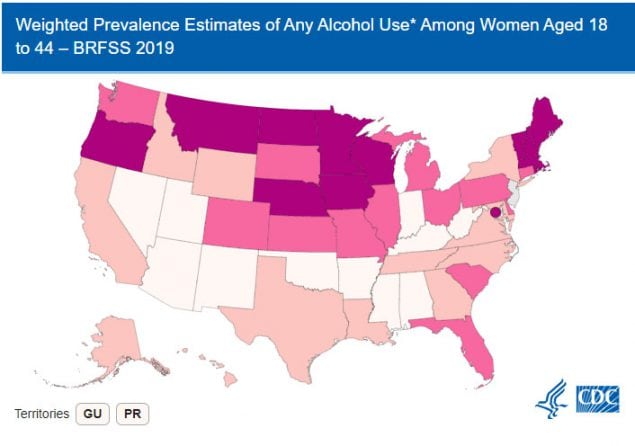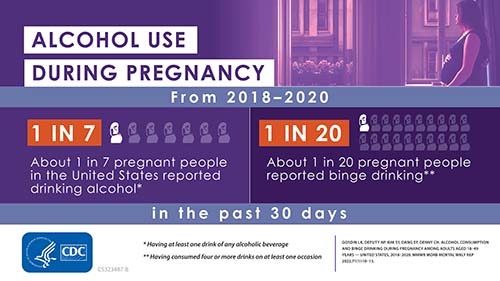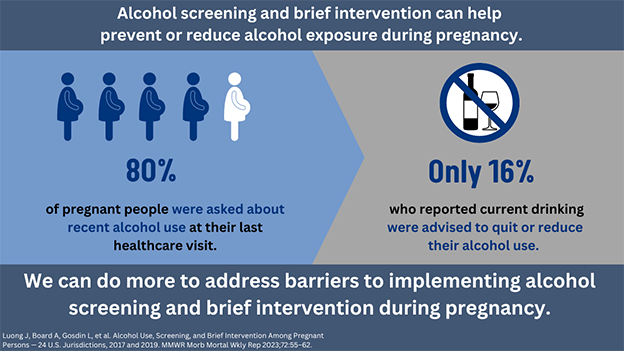Data & Statistics on FASDs
Prevalence of FASDs
- We do not know exactly how many people have fetal alcohol spectrum disorders (FASDs). Several different approaches have been used to estimate how many persons are living with FASDs in the population. FASDs include several diagnoses related to exposure of the baby to alcohol during pregnancy. More specifically, fetal alcohol syndrome (FAS) is the most involved diagnosis, used when several physical and developmental disabilities are present (see Facts about FASDs).
- Using medical and other records, CDC studies have identified about 1 infant with FAS for every 1,000 live births in certain areas of the United States.1 The most recent CDC study analyzed medical and other records and found FAS in 0.3 out of 1,000 children from 7 to 9 years of age. 2
- Studies using in-person assessment of school-aged children in several U.S. communities report higher estimates of FAS: 6 to 9 out of 1,000 children. 3,4
- Few estimates for the full range of FASDs are available. Based on the National Institutes of Health-funded community studies using physical examinations, experts estimate that the full range of FASDs in the United States and some Western European countries might number as high as 1 to 5 per 100 school children (or 1% to 5% of the population).3,4,5
Cost of FASDs
- The lifetime cost of care for one individual with FAS in 2002 was estimated to be $2 million. This is an average for people with FAS and does not include data on people with other FASDs. People with certain disabilities, such as profound intellectual disability, have much higher costs. It is estimated that the cost to the United States for FAS alone is over $4 billion annually. [Read summary]
State-level estimates of alcohol use among women

- Estimates of alcohol use among women of childbearing age vary from state to state. View your state’s alcohol consumption rate in 2019
- Data come from the Behavioral Risk Factor Surveillance System (BRFSS), a telephone survey that tracks national and state-specific self-reported health risk behaviors of adults, 18 years and older, in the United States.
Alcohol Use among Pregnant People in the United States

- In a 2022 Morbidity and Mortality Weekly Report (MMWR), CDC researchers found that nearly 14% (or 1 in 7) pregnant people reported current drinking* and about 5% (or 1 in 20) reported binge drinking† in the past 30 days. Pregnant people who experienced frequent mental distress (14 or more days of poor mental health in the past 30 days) and those who did not have a usual healthcare provider were more likely to report alcohol use.
- A 2020 report published in the American Journal of Preventive Medicine found that both current alcohol use and binge drinking among pregnant women aged 18–44 years in the United States increased slightly from 2011 to 2018. Current drinking (having at least one drink of any alcoholic beverage in the past 30 days) increased from 9.2% in 2011 to 11.3% in 2018.
Screening for Alcohol Use and Brief Counseling

- In a 2023 Morbidity and Mortality Weekly Report (MMWR), CDC researchers found that 80% of people who were pregnant were asked about alcohol use; however, only 16% of those who self-reported drinking within the past 30 days were advised to quit or reduce their use. These findings highlight missed opportunities to integrate alcohol SBI in practice, utilize strategies to address recognized barriers (e.g., improving reimbursement for alcohol SBI), and to help reduce alcohol use during pregnancy.
- A 2020 CDC report found that although 81% of US adults in 13 states and Washington, D.C. reported being asked by their healthcare provider about alcohol use, only about 38% reported being asked about binge drinking during a routine checkup in the last 2 years.
- Among adults who reported being asked about their alcohol use at a checkup in the past 2 years and reported current binge drinking, 80% (or 4 of 5 persons) were not counseled to reduce their drinking. Routine alcohol screening and brief counseling has been shown to be effective at reducing binge drinking and is recommended for all adults.
References
1 CDC. Fetal alcohol syndrome-Alaska, Arizona, Colorado, and New York, 1995-1997. MMWR Morb Mortal Wkly Rep. 2002;51(20):433-5. [Read article]
2 CDC. Fetal Alcohol Syndrome Among Children Aged 7-9 Years – Arizona, Colorado, and New York, 2010. MMWR Morb Mortal Wkly Rep. 2015;64(3):54-57. [Read article]
3 May PA, Baete A, Russo J, Elliott AJ, Blankenship J, Kalberg WO, Buckley D, Brooks M, Hasken J, Abdul-Rahman O, Adam MP, Robinson LK, Manning M, Hoyme HE. Prevalence and characteristics of fetal alcohol spectrum disorders. Pediatrics. 2014;134:855-66. [Read summary]
4 May PA, Gossage JP, Kalberg WO, Robinson LK, Buckley D, Manning M, Hoyme HE. Prevalence and epidemiologic characteristics of FASD from various research methods with an emphasis on recent in-school studies. Dev Disabil Res Rev. 2009;15:176-92. [Read summary]
5 May PA, Chambers CD, Kalberg WO, Zellner J, Feldman H, Buckley D, Kopald D, Hasken JM, Xu R, Honerkamp-Smith G, Taras H, Manning MA, Robinson LK, Adam MP, Abdul-Rahman O, Vaux K, Jewett T, Elliott AJ, Kable JA, Akshoomoff N, Falk D, Arroyo JA, Hereld D, Riley EP, Charness ME, Coles CD, Warren KR, Jones KL, Hoyme HE. Prevalence of Fetal Alcohol Spectrum Disorders in 4 US Communities. Journal of American Medical Association. 2018;319(5):474–482. [Read article]